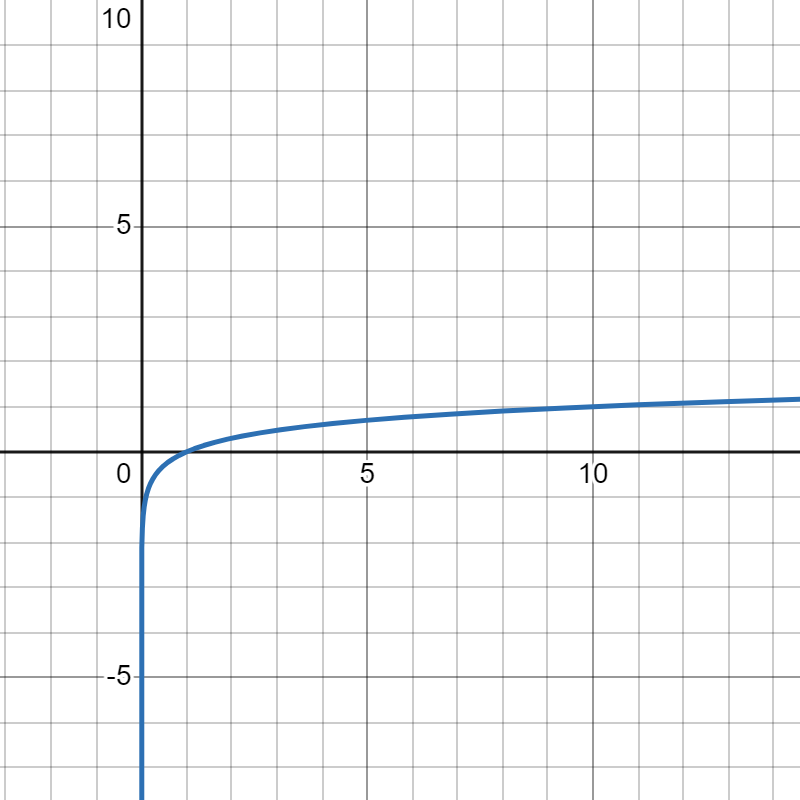6.4E Exercises
( \newcommand{\kernel}{\mathrm{null}\,}\)
Answer True/False. If False, explain why.
- If logax=y, then ax=y.
- If logba=c, then bc=a.
- There is a logarithmic function with base 1, f(x)=log1x.
- The natural log function lnx is the logarithmic function with base π.
- Let f(x)=logax be a logarithmic function (a>0,a≠1). The domain of f is {x|x≥0}.
- Let f(x)=logax be a logarithmic function (a>0,a≠1). The domain of f is {x|x>0}.
- I am allowed to plug in x=−2 to the function f(x)=ln(x+3).
- I am allowed to plug in x=−2 to the function f(x)=ln(x+1).
- For any base a, loga(a)=1.
- For any base a, loga(0)=1.
- For any base a, loga(1)=0.
- For f(x)=log10x and g(x)=10x, we know (g∘f)(x)=x for all x>0.
- Answer
-
- F, this does not match the definition. It must be ay=x.
- T
- F, we do not allow the base a=1. (Why doesn't it make sense?)
- F, it's base e.
- F, we can't have ≥ because 0 is not allowed.
- T
- T
- F, if x=−2 then the input to the log is −2+1=−1, a negative number.
- T
- F, 0 isn't even in the domain.
- T
- T
Answer True/False. If False, justify or find the error.
- The graph of f(x)=log3x passes through (1,0).
- The graph of f(x)=logax passes through (1,a) for any base a.
- The graph of f(x)=logax passes through (a,1) for any base a.
- The graph of the function f(x)=log3x is the reflection of the graph of g(x)=log13x across the x-axis.
- The graph of the function f(x)=lnx is the reflection of the graph of g(x)=ex across the x-axis.
- The graph of f(x)=log2x exhibits faster growth than the graph of g(x)=lnx, for x>1.
- The graph of f(x)=log10x exhibits faster growth than the graph of g(x)=lnx, for x>1.
- Answer
-
- T
- F, it passes through (1,0).
- T
- T
- F, it's the reflection across the line y=x because they're inverse functions.
- T
- F, the base 10>e.
By analyzing signal points like (a,1) and using your knowledge of logarithmic function graphs, match the graphs to their functions.
 |
 |
 |
 |
| 1. | 2. | 3. | 4. |
| f(x)=log10x | g(x)=lnx | h(x)=log12x | p(x)=log2x |
- Answer
-
- p
- g
- f
- h
Without using a calculator, compute the following using the definition and Log Laws:
- log39
- log17(1)
- log2(14)
- lne
- lne4
- log101000
- log24+2log28
- log3(6)−log3(2)
- Answer
-
- 2
- 0
- −2
- 1
- 4
- 3
- 8
- 1 (Hint: consider log3(6)=log3(2⋅3).)
Fully expand or fully condense. Simplify if reasonable.
- log2(x2)
- log10(100x2y3)
- ln(A2+2AB+B2)
- log311+log37
- lnx+lny−2lnz−3ln(w+1)
- 3loga(A+B)−4loga(A−B)
- Answer
-
- log2x−1
- 2+2log10x+3log10y
- 2ln(A+B)
- log3(77)
- ln(xyz2(w+1)3)
- loga((A+B)3(A−B)4)
Answer True/False. Justify your answer.
- log2(2x)=x
- log2(8)=3
- For any base a, loga(xa)=x.
- elnx=x (for x>0)
- elog10x=x (for x>0)
- 10log10x=x (for x>0)
- Answer
-
- T, inverse functions.
- T, write as log2(23)=3log22 or translate with definition.
- F, it should be loga(ax)=x.
- T, inverse functions.
- F, the bases must match.
- T, inverse functions.
By translating back and forth from logarithm form to exponential form, solve for x in the equations below.
- log10(x)=3
- log2(x)=1
- ln(x+1)=4
- log5(5x)=2
- ln(x)−3=0
- 2lnx=4
- Answer
-
- x=1000
- x=2
- x=e4−1
- x=5
- x=e3
- x=e2
1. We saw how exponential functions can be used to calculate interest compounding annually. In fact, you can choose to compound multiple times a year, or even continuously. For continuously compounding interest, the amount of money you have at time t years after investing an initial amount A0 is given by A=A0ert, where r is the interest rate written as a decimal. Say I want to double my money, so that A is 2A0. Then my equation becomes 2=ert. Give the equivalent logarithmic equation. Solve it for t. If the interest rate is 12%, find the time t it will take to double my money. (Use a calculator if needed.)
2. If I take a turkey out of the oven with internal temperature 165∘F and place it in an ambient room temperature of 65∘F, then the amount of time (in minutes) it will take to cool to an internal temperature of T is given by
t=−40ln(T−65100)
Use a calculator to find how long it takes to cool down to 150∘F, 125∘F, and 100∘F.
- Answer
-
1. The equivalent equation is ln(2)=rt. Solved for t, we have t=ln2r. If r=.12, then t≈5.78 years.
2. For T=150∘F, t≈6.5 minutes. For T=125∘F, t≈20.4 minutes. For T=100∘F, t≈42 minutes.


